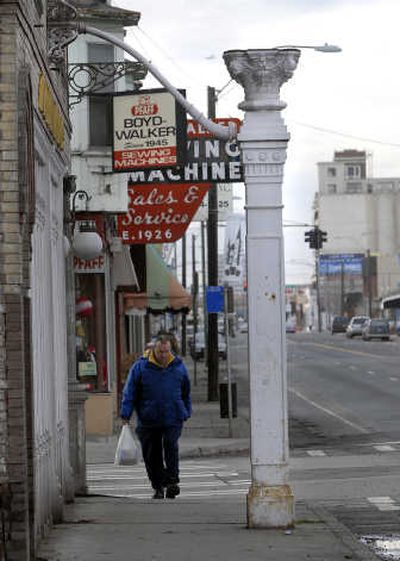Pillar formerly sported clock

From reader Jim McCall: “There is an interesting-looking old structure that appears to be an old clock structure/tower on the sidewalk at the southeast corner of Napa and Sprague. Maybe there is a story there … especially if the clock could be found.”
Yes, there is a story – as there almost always is with old buildings – but, no, the clock couldn’t be found.
It probably was a clock that had been removed from the top of the pillar, not a globe or lamp, said Stephen Emerson, program director of Archaeological and Historic Services at Eastern Washington University.
It’s likely the clock was placed there by the original occupant of the structure at 2002 E. Sprague Ave., Union Park Bank, according to Emerson, who conducted a historic properties survey of buildings along that intersection for the Spokane Transit Authority in 2005 when a light rail system was being considered.
Though now rather weather-worn and suffering from neglect, the two-story brick commercial building was constructed in 1907. The square pillar, made of iron and supported by a decorated pedestal, sits near the curb on the north side of the building, to which it is connected by an iron pipe, which no doubt contained electrical connections.
The building was originally capable of housing four enterprises. The bank moved out of the street-level site in 1917 and a succession of businesses have come and gone over the years – including F.F.C. Schimmer confectionary (1936-39), Post Office Station B (1938-52), the Silver Streak Beer Parlor (1938-61), Spokane Television Service (1954-87), the Napa Tavern (1963-83) and others.
The ground floor has largely been vacant since 1987. The upper floors had such tenants as printer A.D. Gaisford in 1910, the Power City chapter of the Independent Order of Odd Fellows (1926-approximately 1940), the Dillard C. Runyon Post 3064 of the Veterans of Foreign Wars and the Spokane Dog Training Club (1971-87).
Emerson states that because of its long association with a diverse group of civic and commercial enterprises, the structure is eligible for listing on the National Register of Historic Places under criteria for buildings that are associated with events that have made a significant contribution to the broad patterns of history.
This now-run down, somewhat derelict-looking building could use a champion to make that happen.